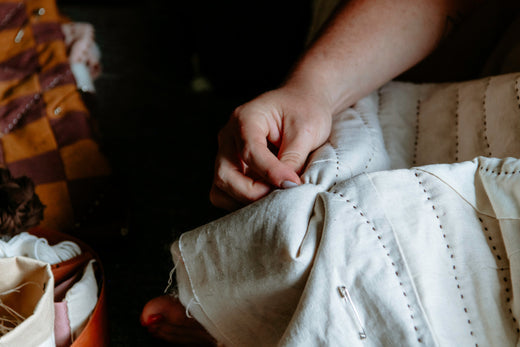Quilting is a treasured craft that has been practiced for centuries. It transforms fabric scraps into beautiful and meaningful creations. For both seasoned quilters and novices alike, the choice between hand quilting and machine quilting can lead to heated debates. Each method offers its unique advantages and quirks. In this article, we will explore the benefits of hand quilting versus machine quilting, examining why one might be more suitable for you based on your preferences, skills, and desired outcomes. Let’s dive into the world of sewing and discover what makes each of these techniques special.
Understanding the Basics of Hand Quilting
Hand quilting is a traditional sewing method that involves stitching layers of fabric together using needle and thread by hand. This age-old technique creates a lovingly crafted quilt that often carries a sense of personal touch and warmth. The slower pace of hand quilting allows for a more intimate connection with the fabric and the quilting process itself.
Benefits of Hand Quilting
- Artistic Expression: Hand quilting enables greater artistic expression. Each stitch can be uniquely placed, enhancing the design elements while allowing for individual creativity.
- Comfort and Relaxation: Many sewists find hand quilting meditative. The repetitive motion can be relaxing, providing a great way to unwind while creating something beautiful.
- Stronger Connection to Tradition: Hand quilting connects you to generations of quilters who have shared this passion over centuries. It's a way of honoring the craft and learning from the past.
- Customization: You can easily modify designs, allowing for more personalized creations. Perhaps you want to add some intricate stitching or create a unique pattern – hand quilting lets you do just that.
- Portable: With just a few supplies, you can take hand quilting anywhere. It’s perfect for sewing groups, waiting rooms, or even a cozy evening at home.
- Slower Pace: Hand quilting promotes a slower, more deliberate crafting pace, allowing you to appreciate each stage of the process.
Machine Quilting: The Modern Approach
On the other hand, machine quilting has gained popularity with the advancement of sewing technology. This technique uses a sewing machine to stitch through the quilt layers quickly and efficiently. While some may view machine quilting as less personal or creative, it also holds numerous benefits that have made it a favorite in contemporary quilt-making.
Benefits of Machine Quilting
- Speed and Efficiency: The primary advantage of machine quilting is speed. You can complete a quilt in a fraction of the time it would take to hand quilt, making it ideal for those with time constraints.
- Precision and Consistency: Machine quilting allows for more uniform stitches, resulting in a polished, professional look for your quilts.
- Complex Patterns Made Easy: Modern sewing machines often come equipped with various stitch options and patterns, allowing you to produce intricate designs that might prove challenging by hand.
- Less Physical Strain: Since machine quilting can be faster, it can reduce the overall physical strain associated with lengthy sewing sessions.
- Quicker Projects: If you’re working on a quilt for an upcoming event or gift, machine quilting can help you get it finished and presented in ample time.
- Use of Technology: Many machines come with features such as automatic stitch regulation, making it easier than ever to achieve excellent results.
Choosing Your Path: Hand Quilting or Machine Quilting?
With the benefits listed for both hand and machine quilting, how do you decide which path to take? Your choice ultimately depends on your individual preferences, the project at hand, and your experience level in sewing. Here are some factors to consider:
Your Skill Set
If you’re a beginner, starting with machine quilting can help you gain confidence quickly and allow you to practice accurately. However, if you see beauty in the methodical approach of hand quilting, you may choose to embrace that challenge instead. On the other hand, if you’re a seasoned sewist with a desire to deepen your skills, taking the time to learn hand quilting techniques could unlock new creative possibilities.
The Nature of Your Project
Consider the type of quilt you want to create. Is it a labor of love for a special occasion or a functional piece for everyday use? Generally, hand quilting suits smaller, more sentimental projects, while machine quilting is excellent for larger items or when under time constraints. For example, throw quilts, baby blankets, or quilts that require intricate designs often benefit from machine quilting.
Personal Preferences
Your approach to sewing might also dictate your choice. If you prefer an artistic, leisurely experience, hand quilting will likely resonate with you more. However, if you’re drawn to efficiency and modern technology, machine quilting could be the way to go.
Combining Techniques for the Best of Both Worlds
Just as in life, you don’t have to choose one path or the other. Many quilters find joy in combining the two techniques to harness the unique benefits of each. For instance, you might choose to piece a quilt top by machine and or opt to finish it by hand. This hybrid approach allows you to enjoy the efficiency of machine quilting while also giving your finished quilt a personal touch with hand-stitched details.
The Social Aspect of Quilting
Another key benefit that both hand and machine quilting share is the community surrounding quilting. Sewists gather for quilting bees, meetups, and classes, sharing techniques, experiences, and wonderful stories. As you explore hand quilting versus machine quilting, don’t hesitate to seek out local sewing groups or classes at your nearest fabric store. You’re sure to meet people who share your love for sewing, and you might learn something new along the way!
Building Your Skills and Finding Your Style
Whether you gravitate toward the slow and steady methods of hand quilting or the fast pace of machine quilting, there’s no right or wrong answer. The more you practice and experiment, the more confident you’ll become in your sewing abilities. Consider taking classes or watching online tutorials focused on techniques associated with both methods. These resources can help you refine your style and help you adapt when you are pursuing new projects.
Diving Deeper into Fabric Selection
Choosing the right fabric is crucial for both hand and machine quilting. Think about the weight, type, and quality of the fabric you want to work with. Some fabrics are better suited for machine quilting, while others shine in hand-quilted projects. Cotton remains the most popular choice, but you might also explore blended fabrics for a unique touch. Your choices of fabric will significantly affect the final look and feel of your quilt.
Final Thoughts: Embracing Your Quilting Journey
No matter which method you choose—whether it be hand quilting, machine quilting, or a delightful blend of both—what matters is enjoying the process of creating. Quilting is a wonderful way to express your creativity, build skills in sewing, and produce lasting treasures that can be passed down through generations. So grab your fabric, choose your method, and let your quilting adventure unfold!

